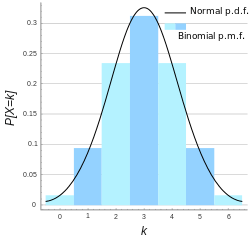Univariate distribution
in statistics, a univariate distribution is a probability distribution of only one random variable. This is in contrast to a multivariate distribution, the probability distribution of a random vector (consisting of multiple random variables).
Examples
One of the simplest examples of a discrete univariate distribution is the discrete uniform distribution, where all elements of a finite set are equally likely. It is the probability model for the outcomes of tossing a fair coin, rolling a fair die, etc. The univariate continuous uniform distribution on an interval [a, b] has the property that all sub-intervals of the same length are equally likely.

Other examples of discrete univariate distributions include the binomial, geometric, negative binomial, and Poisson distributions.[1] At least 750 univariate discrete distributions have been reported in the literature.[2]
Examples of commonly applied continuous univariate distributions[3] include the normal distribution, Student's t distribution, chisquare distribution, F distribution, exponential and gamma distributions.
See also
- Univariate
- Bivariate distribution
- List of probability distributions
References
- Johnson, N.L., Kemp, A.W., and Kotz, S. (2005) Discrete Univariate Distributions, 3rd Edition, Wiley, ISBN 978-0-471-27246-5.
- Wimmer G, Altmann G (1999) Thesaurus of univariate discrete probability distributions. STAMM Verlag GmbH Essen, 1st ed XXVII ISBN 3-87773-025-6
- Johnson N.L., Kotz S, Balakrishnan N. (1994) Continuous Univariate Distributions Vol 1. Wiley Series in Probability and Statistics.
Further reading
- Leemis, L. M.; McQueston, J. T. (2008). "Univariate Distribution Relationships" (PDF). The American Statistician. 62: 45–53. doi:10.1198/000313008X270448.
